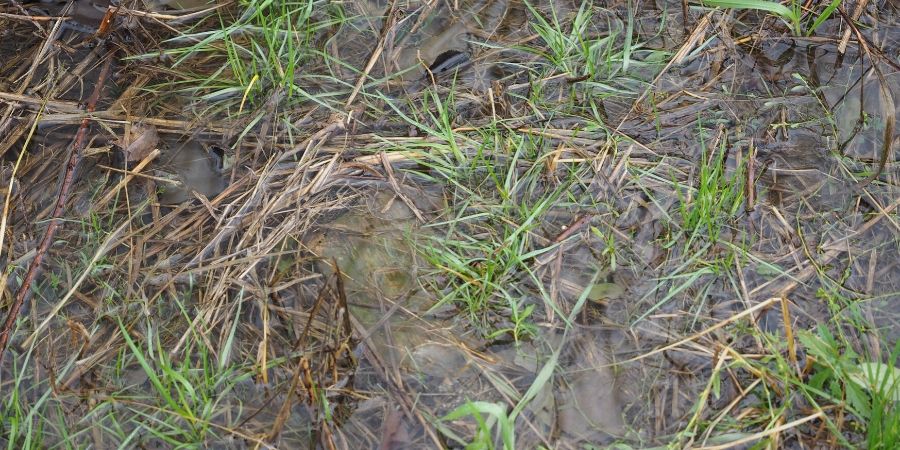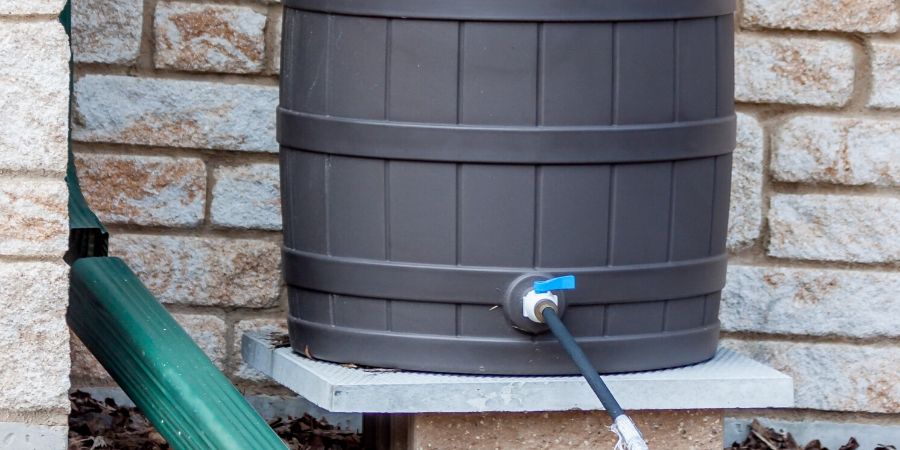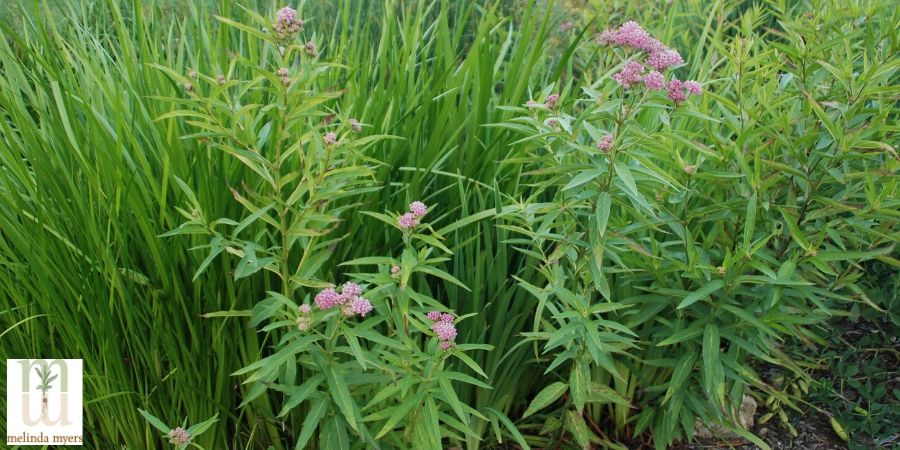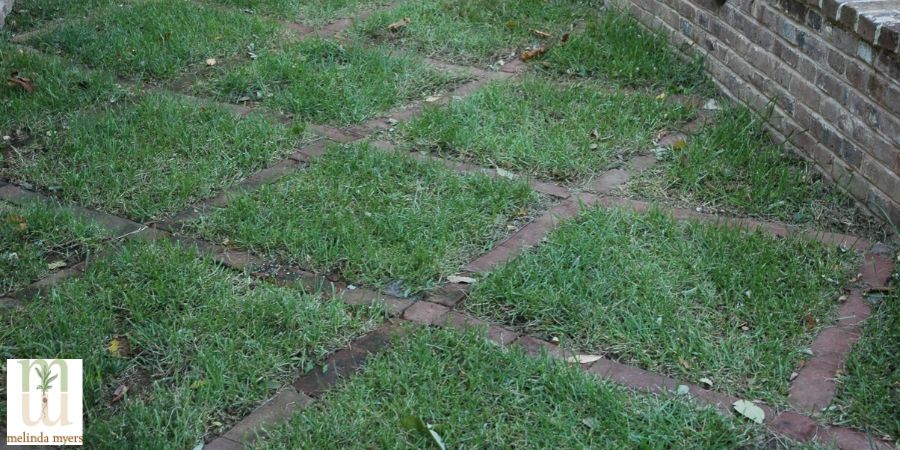Seven Steps to Managing Water in Your Landscape
- horticulturist and gardening expertApril 25, 2020
Flooded streets, yards, and basements have all of us looking for ways to manage water in our landscape. Sustainable water use helps us grow beautiful gardens while reducing water pollution and protecting our home, gardens, and waterways.
Here are seven strategies you can enlist in your landscape to help protect our water as you plan, plant, and tend your landscape.
1) Convert Your Soil into a Water Retaining Sponge
Create a healthy soil foundation to grow beautiful and vibrant plants that require less maintenance. You’ll also help reduce water runoff, flooding, and pollution. Amending soil so it is better able to absorb rainwater keeps it on our landscape, benefitting our plants and out of the storm sewers. This soil along with plant roots helps remove pollutants from the water before it enters the groundwater and aquifer.
But most of us are gardening in poor quality heavy clay, sandy, drought, and otherwise less-than-ideal soil. Topsoil is often removed during construction leaving poor quality subsoil behind. An inch or two of topsoil is often spread over the surface before laying sod and planting a few trees and shrubs.
As you begin gardening in this “soil” you uncover the poor quality growing conditions that lie beneath your feet. If you are struggling with heavy compacted clay soil you find it drains slowly, water may pool on the lawn or garden beds and the soil stays waterlogged. This limits oxygen in the soil that plants need to absorb nutrients and water. Those gardening in sand, gravel, or rock-filled soils have the opposite problem. These soils drain too quickly for plants to absorb needed water and nutrients. This means more frequent watering and fertilization is needed to maintain plants.

Water pooling in lawn
Whether you’re dealing with fast-draining or heavy soils, organic matter is the solution. Organic matter adds nutrients but also improves drainage and aeration in heavy soil and increases water- and nutrient-holding capacity in fast-draining soils.
Adding organic matter such as compost also builds the soil eco-system. It increases the number and activity of beneficial soil organisms such as good bacteria, fungi, microorganisms, and insects. As the compost breaks down it provides a variety of essential plant nutrients over a long period of time. Plants growing in soil amended with compost have fewer insect and disease problems and produce more produce and flowers.
Organic matter also improves water quality and the environment. The organic matter in amended soils acts like a sponge. More water is absorbed by the soil and less runoff. This means less fertilizer and pesticides wash into nearby storm sewers, rivers, and lakes.
More stormwater can infiltrate amended soils so less rainfall runs off the soil surface. This helps keep water where it falls and fertilizers were applied instead of overloading our storm sewers and potentially polluting our waterways.
Using Milorganite when fertilizing can further improve your soil. This slow-release fertilizer contains 85% organic matter that feeds the soil microorganisms and your plants improving all soil types.
2) Use Rain Barrels to Capture Rainwater
Don’t let all that rainwater run off the roof and down the storm sewer. Capture it with a rain barrel to use for watering gardens and containers. This century-old technique helps conserve water and reduce water pollution.
Start with a call to your local municipality. Some have restrictions on water harvesting, but most encourage this practice and some even offer rebates.
Purchase a rain barrel or make your own from a recycled food-grade container. Evaluate the functional design, not just appearance when making your selection.
Make sure the top is covered to keep out debris, mosquitoes, and other bugs. The rain barrel may have a solid lid with an opening just large enough to accommodate the downspout. Or the top may be covered with a screen to keep out unwanted bugs and debris while letting in the rain.
The spigot should be low on the barrel so water does not stagnate at the bottom. Use the spigot to fill watering cans or attach a hose for watering. An overflow outlet near the top of the barrel is necessary for periods of heavy rain and for interlocking several barrels.

Rain Barrel Attached to Downspout
A downspout diverter is another way to manage rain barrel overflows. Once the barrel is full, the diverter directs the water back to the downspout instead of into the rain barrel.
Use a stack of pavers, a stand or decorative support to elevate your rain barrel. This provides easier access to the spigot when filling containers and speeds water flow with the help of gravity.
Start your conversion to rain barrels one downspout at a time. You can capture as much as 623 gallons of water from one inch of rain falling on 1000 square feet of roof. This can be a lot to manage when first implementing this change.
Make your rain barrel an attractive addition to the landscape. One gardener placed her rain barrels between the garage and her neighbor’s fence. She diverted water from the garage roof to several interlocking rain barrels. This is a creative use of a challenging space while keeping the rain barrels out of sight but accessible.
Or screen the rain barrels from view with the help of fencing, vine-covered trellises, upright shrubs, ornamental grasses, and other plantings. Just make sure you have easy access to the spigot for retrieving water.
Perhaps you’d rather turn your rain barrel into a work of art with a bit of paint suited for outdoor use on plastic surfaces. And don't worry if you are not an artist just pick up some stencils or invite creative friends or children in the family to get involved.
3) Grow More Native Plants
Whether gardening on a small city lot or a larger property, you can add pollinator-friendly native plants to your landscape. These deeply rooted plants help keep rainwater where it falls, reducing the risk of basement flooding and overwhelming storm sewers.
The plants slow the flow of water keeping much of it on your property and out of the storm sewers. Their deep roots create pathways for rainwater to enter and travel through the soil. Plant roots and soil help remove impurities from the water before it enters the groundwater and aquifers.
Start small by adding native plants to your existing gardens. As a plant needs replacing, or you start a new garden, look for a native plant that thrives in the growing conditions and is the right size and bloom time for your garden design.
Once you experience the beauty and benefits of native plants, take the next step and plant a garden of only native plants. Design it like you would any flower garden. Include a variety of native plants so your garden will be filled with flowers throughout the season and seed heads in winter to attract birds and provide homes for beneficial insects.
Select plants that are equally assertive so the more aggressive plants do not overrun those that are more timid. Look for those that are slow to spread and don’t reseed readily to reduce the need for regular thinning and dividing.
Use a mix of grasses and flowering plants for aesthetic, bird, and pollinator appeal. Selecting the right plant for the growing conditions and garden space will mean less maintenance on your part.
With experience, you may consider going all out and convert a large portion of your whole yard into a natural garden. Look to nature for design ideas and include a birdbath, fence, or other signs of intent. These let your neighbors know this is a garden you designed.
4) Plant a Rain Garden to Manage Water in Your Landscape
Install rain gardens and improve the health and beauty of your landscape and environment. Rain gardens are specifically designed to intercept and temporarily hold excess water flowing off walks, drives, roofs and other hard surfaces. As the rainwater filters through the plant roots and soil in the rain garden, it removes impurities before entering the groundwater. This helps conserve and utilize rainwater on your property reducing the risk of flooding and storm water overflows.
Design your rain garden just like you would other gardens in the landscape. Start with a plan, commit to doing soil preparation, and select plants suited to all the other growing conditions in your area. Check with your local municipality for any restrictions or possible rebates related to installing rain gardens.
Contact your state’s Department of Natural Resources and University Extension Service for information on designing, installing, and caring for rain gardens in your area.
Proper planning will increase the effectiveness and beauty of your garden. Placement is important. Design your garden at least 10 feet away from your house on a downward slope so the water drains away from your home’s foundation. Locate the garden where it intercepts and collects runoff before it reaches the storm sewer.

Rain Garden
Avoid areas where water naturally collects and stands for long periods or the water table is near the soil surface. Consider creating a wetland garden filled with native wetland plants or a dry riverbed in these areas.
Keep rain gardens away from septic systems, tree roots, water lateral, utilities, and wells. Contact your local municipality or Department of Natural Resources (DNR) for any placement requirements. Always call 811, a free underground utility locating service, at least three days before you start digging. They’ll contact all the appropriate companies who will mark the location of their underground utilities in your work area. This helps eliminate the danger and inconvenience of accidentally knocking out power, cable, or other utilities while you create your beautiful rain garden.
5) Create a Water Absorbing Lawn
If you dedicate a portion of your landscape to lawn, make it as environmentally friendly as possible. Provide proper care to maximize its vigor and positive contribution to managing stormwater.
Mow high to reduce the rate of stormwater runoff and encourage deeper and denser roots. Deeply rooted grass is more drought-tolerant, pest-resistant, and better able to outcompete the weeds. The denser root system absorbs more water so less runs off the lawn and into the storm sewer. The dense grass covers the soil reducing soil erosion and pollutants from entering waterways.
Mow often removing no more than one-third of the total grass at one time. This is less stressful on the lawn and the shorter clippings will break down quickly adding moisture, nutrients, and organic matter to the soil. A season’s worth of clippings is equal to one fertilizer application.
Have your soil tested before you begin fertilizing. The results will tell you what type and how much if any fertilizer is needed. Some states and communities have banned fertilizers that contain phosphorous unless a soil test shows it is needed. The phosphorus in Milorganite is in a recycled, “bound” form and is slowly released at a rate plants can use. This type of phosphorus significantly reduces the likelihood of leaching or runoff.
Fertilize using a low nitrogen slow release fertilizer like Milorganite, which provides small amounts of nutrients over a longer period of time. This promotes slow steady growth as well as balanced top and root growth resulting in more drought tolerant and pest resistant grass.
Always sweep clippings and fertilizer off walks, drives, and other hard surfaces keeping them out of our waterways where they contribute to water pollution.
6) Trees Help Manage Water
When celebrating Arbor Day as children we learned about some of the benefits trees provide. Trees give off oxygen, shade our homes, remove pollutants from the air, and more. But their role in managing stormwater was generally overlooked. These important members of our community help keep water where it falls, combat flooding, and reduce water pollution.
As rain falls onto a tree the leaves and stems help slow the velocity of the rainwater. Some of that water is captured in the leaf canopy and eventually evaporates back into the atmosphere. The rest travels down the trunk and branches at a much slower speed than the rainwater that lands directly on the soil. This slower rate of travel allows the soil to absorb more of the rainfall so less runs off into the street.
The leaf litter, groundcover, or mulch beneath the tree protects the soil from erosion. These also help capture some of the stormwater. This combined with the pathways created by their roots and the trees allows water to infiltrate the soil. As the water passes over the tree, through plant leaves and stems, mulch, and roots many of the pollutants are removed.
When water reaches the soil the trees serve as nature’s sponges. They absorb large quantities of stormwater and hold it in their roots until it is moved through and used by the rest of the tree. Much of the water passes through the tree and is eventually released into the atmosphere through transpiration.
The remaining rainwater enters and moves through the soil into the groundwater and aquifer. All this helps reduce stormwater runoff, water pollution, and flooding potential.

Permeable Steppers
7) Permeable Walks, Patio and Other Hard Surfaces
When adding walks, patios or other hard surfaces consider enlisting permeable options. Permeable pavers allow water to infiltrate the surface rather than run off into the street and storm sewer.
Steppers interplanted with groundcovers make an attractive walkway or patio. Select groundcovers suited to the growing conditions and those that tolerate foot traffic. The planted spaces between the hard surfaces allow water to move into and through the soil.
As you can see implementing a few changes in your landscape can help keep water on your landscape to help you grow a healthy and beautiful landscape. It will also help keep excess and polluted water from flooding our basements, streets, and storm sewers. All this helps protect our waterways and lakes.

